To make a podcast, remove pauses from a webinar recording, or add effects to a video soundtrack, you’ll need audio editing software. It allows you to record audio, reduce file size, convert to web-friendly formats, and clean up older recordings.
There is no shortage of audio editors to select from. Which option you choose is determined on your goals, budget, and skill level.
After reviewing over 50 apps and conducting extensive testing on dozens of rivals, here are my top selections for the finest audio editors.
Table of Contents
The Seven Best Audio Editors
- Adobe Audition is the most powerful audio editor.
- Audacity, the greatest free audio editor.
- Acoustica Standard Edition is a cost-effective alternative to Adobe Audition.
- Hindenburg PRO 2 for Journalists and Podcasters
- SOUND FORGE Audio Studio 17 for Windows users on affordable prices
- Audiate for transcription-based audio editing.
- AudioMass offers free, browser-based audio editing.
What distinguishes the finest audio editor?
The greatest audio editors are specifically developed with audio editing in mind. Many digital audio workstations (DAWs) offer audio editing features as part of a much larger feature set, which can make them bulkier and more expensive. I only included actual audio editors in this list, so you won’t find tools like GarageBand, Ableton Live, or AVID Pro Tools.
Some of these options are unique, but each app had to meet a basic set of criteria to be included for the list.
- Basic editing features that make audio editing simple, intuitive, and enjoyable. This offers typical waveform editing, multi-track editing, and a large variety of file formats. Any of these apps should allow you to reduce the size of an audio file or merge two recordings. (These types of simple waveform edits are sometimes referred to as destructive editing, in which changes you make to the file overwrite the original when you click Save.)
- Plugins are one-click actions for applying automatic or configurable effects, as well as any AI-powered tools that simplify editing. These capabilities are intended to make it simple to recover poor recordings, modify equalizer settings, add reverb or echo, and manipulate audio in creative ways.
- Overall usability, including interface design, support documentation, and active support communities. I also noticed whether the software provides a tour of its capabilities when you first use it.
- Value for money. With so many free audio editors accessible, premium programs must deliver a solid feeling of value by offering best-in-class capabilities, unique tools, and other things that are typically not included for free. Though free apps inherently provide excellent value, only the best were selected for inclusion on the final list.
- Any additional integrations, bonuses, or extras that an audio editor may find valuable. This might include cloud storage connection, sharing and publishing facilities, a sound effects archive, quick access to extra plugins or themes, and anything in between.
To test the apps, I performed a series of basic adjustments in waveform view, including noise reduction and file exporting, before putting any special capabilities to the test. After tinkering with dozens of apps, these are the best audio editors I found.
A quick overview of the greatest audio editing software.
| Best for | Standout feature | Pricing | |
| Adobe Audition | Powerful features at a price | Industry-standard audio editing | $20.99/month (Single app), $54.99/month (Creative Cloud) |
| Audacity | Free audio editing | Open source but very powerful | Free |
| Acoustica Standard Edition | A budget alternative to Adobe Audition | Complex effect chains | $59.90 (Standard Edition), $199.90 (Premium Edition) |
| Hindenburg Pro 2 | Journalists and podcasters | Auto-leveling | $12/month (Standard), $15/month (Plus), $30/month (Premium) |
| SOUND FORGE Audio Studio 17 | Windows users on a budget | Video integration | $59.99 (Single License), $2.99/month (Audio Studio 365) |
| Audiate | Editing recordings like a text document | Transcription-based editing | $29.99/month or $199.99/year |
| AudioMass | Browser-based audio editing | Simple interface | Free |
Best audio editor with powerful features at a reasonable price.
Adobe Audition (macOS, Windows):

Adobe Audition Pros:
- A feature-rich audio editor with single and multi-track capabilities
- Works with various Adobe programs, including Premiere Pro.
Cons of Adobe Audition:
- Expensive
- The subscription approach implies you can’t buy it altogether.
Adobe Audition is a powerful audio editor that continues to advance industry standards, with a pricing plan to match. Every year, the software is updated with new features and improved compatibility with the most recent macOS and Windows versions.
Audition can be used as a single-track audio editor or a multi-track mixer to record and layer sounds. It is a full-featured digital audio workstation that can record several sources simultaneously as well as external plugins (VST, VST3, and AU). Adobe has also included best-in-class audio restoration capabilities, which allow you to select a sample of “noise” in your recording and then eliminate that undesired range of sound from the entire file. To reduce pops and clicks, you can utilize adaptive noise reduction (which automatically recognizes unpleasant sounds for you) as well as automatic or spot healing.
You can save commonly used activities so they are always accessible from the Favorites menu. Audition’s interface is easily customizable to fit your present activity, with layouts for audio to video editing, radio production, and dual-monitor configurations. There are even templates to help with multi-track editing of projects like radio voiceovers, podcasts, and surround-sound movie production. Audition supports video tracks (in addition to mono, stereo, and 5.1) and allows you to see the reference video while editing.
All of these features make Adobe Audition an extremely capable, albeit pricey, audio editor. Though complicated in nature, Adobe’s video tutorials present many of the capabilities in an easy-to-digest format. If you purchase an Adobe Creative Cloud subscription, you can upload audio clips from the Premiere Pro video editor directly to Adobe Audition for editing and processing.
Adobe Audition costs: $20.99 per month (billed annually) for a single software plan, and $54.99 per month (paid annually) for a Creative Cloud plan that includes access to Adobe’s whole app suite, including Photoshop, Premiere Pro, and Illustrator.
Best free audio editor.
Audacity (macOS, Windows, Linux)
Audacity Advantages:
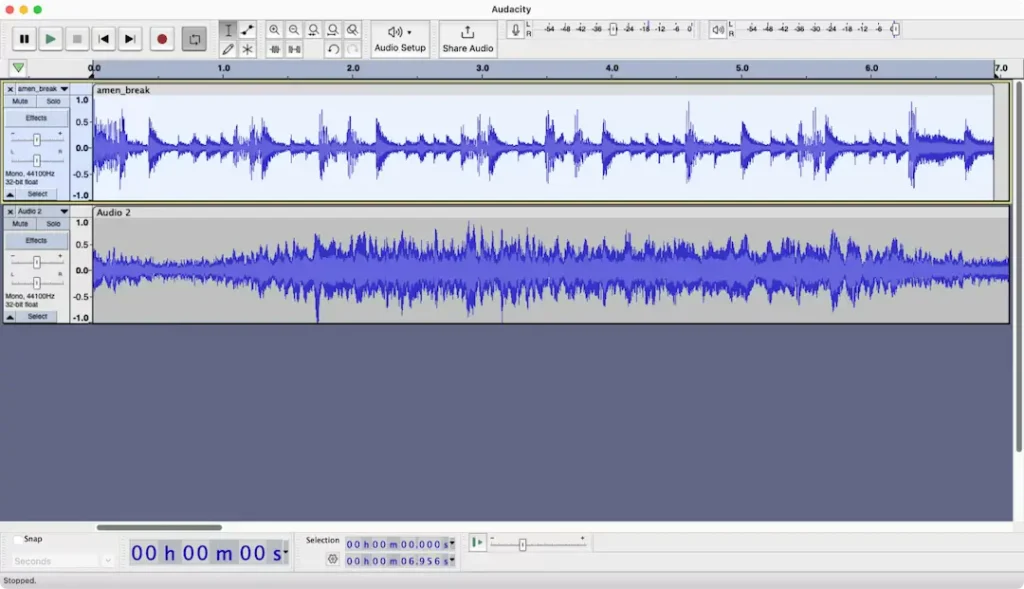
- Simple but effective single- and multi-track editing for free
- Apply individual effects or utilize an effect chain.
Cons of Audacity:
- lacks the elegance and features of premium items.
Audacity is the most powerful free audio editor that money cannot buy. It features a comprehensive range of editing and mastering tools, such as destructive waveform editing and multi-track mixing. Despite using an open-source development paradigm, Audacity includes numerous capabilities that are often associated with premium products.
The editor provides you with a library of effects, which includes a compressor, noise reduction, and an automatic repair tool. External audio effects and plugins are also supported, including VST, AU (on Mac), LADSPA, and LV2 formats. You may also get several plugins from the Audacity Plugins database. And, thanks to its open source roots, Audacity can import and export a variety of formats, including Ogg Vorbis, FLAC, and M4A.
Its simplistic and slightly clumsy interface puts it at a disadvantage when compared to its competitors. You also cannot record numerous audio sources simultaneously or make non-destructive modifications. I can overlook the drawbacks because it is free of charge. Audacity is adequate for the great majority of users who require a simple tool to edit or enhance their audio.
Audacity’s pricing is free.
The greatest cheap alternative to Adobe Audition.
Acoustica Standard Edition (macOS, Windows)
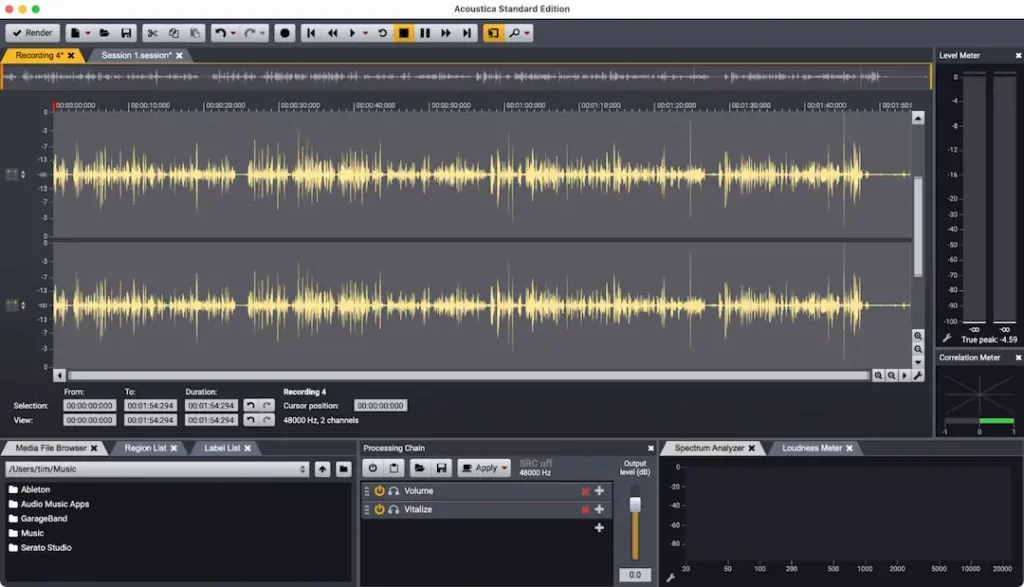
Acoustica pros:
- A tabbed interface allows both single and multi-track editing.
- Use complicated processing chains to enhance or clean up audio.
Acoustica disadvantages:
- Less feature-rich than Adobe Audition.
Acoustica Standard Edition provides more than the ordinary free audio editor in a cost-effective bundle. It’s a high-resolution audio editor that supports 32-bit audio and sample rates up to 384 kHz. Acoustica is suitable for both single-track waveform editing and multi-track mixing, with the ability to loop, stretch, and fade clips on a timeline.
Basic effects include a limiter, an equalization, and a collection of audio restoration tools for removing hiss, pop, and hum from recordings. Acoustica also supports external plugins in VST, VST3, and AU formats (on Mac). Each of these can be linked together, stored, and deployed with a single click across numerous sessions and files. Create your effects in the Processing Chain box on the main interface by clicking the Add button and adding equalizers, limiters, plugins, and other components. Acoustica is also compatible with basic broadcast protocols, making it simple to deal with video soundtracks.
Acoustica’s clean row of handy icons, dark color scheme, and tab-based interface for working on several files should keep you from becoming overwhelmed by its enormous feature set. If you crave more “professional” features, Acoustica’s Premium Edition includes improved audio restoration tools, multi-channel 7.1 surround sound support, and spectral editing.
Acoustica Price: $59.90 for the Standard Edition and $199.90 for the Premium Edition.
Best audio editor for journalists and podcasters
Hindenburg Pro 2 (macOS, Windows)
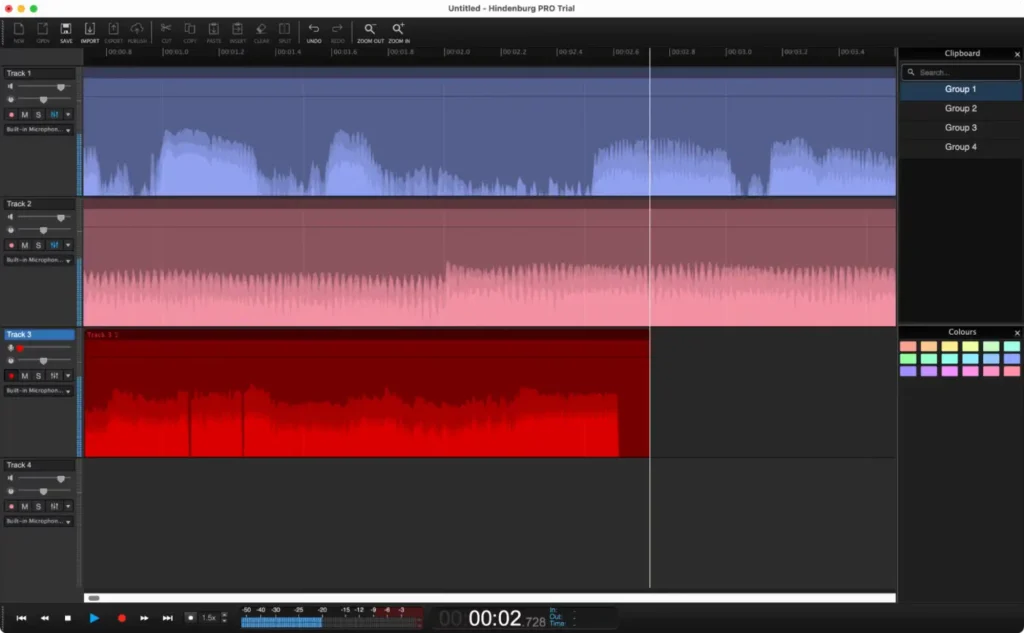
Hindenburg Pro 2 Pros:
- Journalists and podcasters use multi-track mixing and editing.
- Auto-leveling and extra effects to enhance spoken word recordings
Hindenburg Pros and cons:
- Geared mostly toward spoken word; quite unsuited for other uses.
- Transcription features are locked behind more expensive subscriptions.
Hindenburg Pro 2 is a multi-track audio editor designed for professional podcasters and radio content creators. The software can be used as a mobile recording studio, assigning separate tracks to different inputs, or as an editor to arrange files recorded elsewhere. It’s ideal for editing interviews or creating podcasts because it handles some of the technical aspects of production for you.
One of the app’s notable features is the ability to automatically modify levels. As soon as you finish recording or importing a waveform, Hindenburg Pro 2 will automatically boost or decrease the track’s volume to meet modern loudness requirements. To optimize your audio for publication, use the built-in profiler, which is an automated equalization for boosting voice tracks.
Hindenburg makes it simple to plan and organize projects on a schedule. You can add markers or segregate audio by chapter when recording to avoid missing critical sound snippets. The app’s clipboard function divides your sound bites, music, ambiance, and other audio clips into four groups, and you can use a custom shortcut to paste the top one.
In addition, you will have access to Soundly’s library of sounds for use in your project. Hindenburg Pro 2 is built around a decent basic audio editor that allows you to choose waveform audio, delete chunks, and relocate clips. You may add simple fades, and if you upgrade to the Plus or Premium tiers, the program even offers automated transcribing.
Hindenburg Pro 2 costs: $12 per month for the Standard tier, with upgrades to Plus ($15 per month) and Premium ($30 per month).
Best Audio Editor for Windows Users on a Budget
SOUND FORGE Audio Studio 17 (Windows)
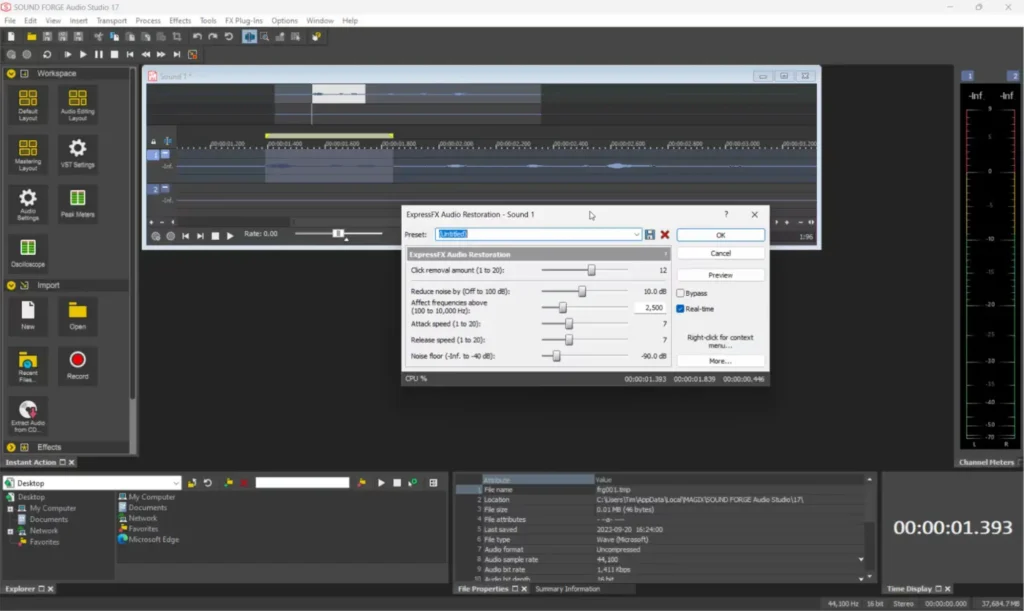
SOUND FORGE Audio Studio 17 Pros:
- Single-track, multi-channel editor that supports video.
- Excellent for creating complicated effect chains and mastering music using
SOUND FORGE Audio Studio 17 Cons:
- No multi-track editing.
SOUND FORGE Audio Studio 17 is a reasonably priced audio editor for Windows. The tool outperforms freebies like Audacity while also providing a “buy it outright” single license option that Adobe Audition lacks. The program offers a balanced set of features, including advanced options like multi-channel editing (up to six channels) and the ability to edit audio linked to video files, though it does not support multi-track editing.
Audio Studio 17 focuses on single-track file editing and recording. The program can safely perform common tasks like as chopping up files, merging recordings into a single file, cleaning up audio, and applying effects. Audio Studio 17 includes iZotope Ozone Elements, a dedicated mastering processor that functions as a plugin in the main software. Ozone offers professionally developed presets that will make your recordings sound richer and punchier with no effort.
Audio Studio 17’s video integration is one of its strongest qualities. When you open a video file, you can see the individual frames on the timeline as you edit. When you’ve adjusted your music, you can easily incorporate it back into the video without having to re-render anything.
SOUND FORGE Audio Studio 17 is one of the most convincing solutions for applying various effects to your audio files, with a plethora of built-in effects and the possibility to add additional via VST2 and VST3 plugins.
SOUND FORGE Audio Studio 17 costs $59.99 and is also available as Audio Studio 365 for $2.99 per month.
The greatest audio editor for modifying recordings as a text document.
Audiate (Windows and MacOS)
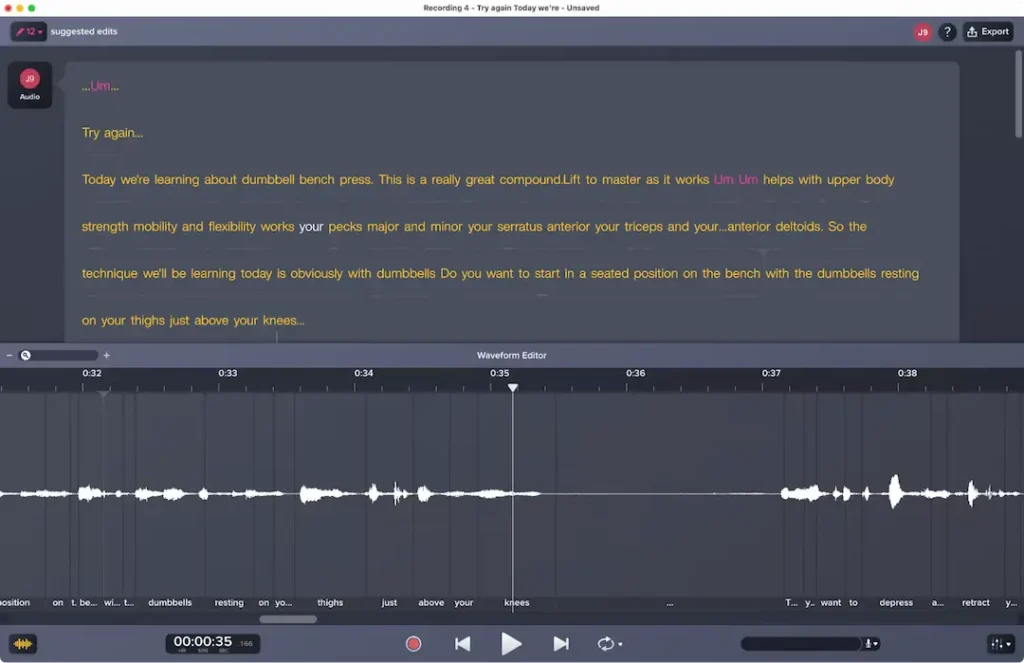
Audite pros:
- Transcription-based editing allows you to modify audio as a written document.
- Access the waveform and edit audio files the traditional way, if you want to.
Audience cons:
- Designed for spoken word; not suitable for editing sound effects or music.
- Expensive subscription model.
Audiate is a unique audio editor and one of the best I’ve tested. You can record directly in the app or access recordings in Audiate and transcribe them to text. From there, simply edit your (spoken word) as you would a text document, while Audiate handles the technical aspects of altering the waveform.
The transcription tools are extremely effective; however, if Audiate misses a word, you can amend the text without losing any information. Along with a new style of AI-powered editing, Audiate features classic waveform audio editing, allowing you to get your hands filthy if you desire. The program is a non-destructive editor that includes useful editing shortcuts such as “Insert silence before” and “Insert silence after” to break up text.
In addition, you can alter a clip’s settings to add audio quality effects such as noise reduction, volume leveling, and plosive, clipping, and undesirable reverb removal tools.
The program is user-friendly, and the opportunity to exit your edit with a written transcript is an added advantage. With that in mind, Audiate is a costly tool that is probably not worth the investment unless you notice a productivity increase from this type of editing.
Audiate price is $29.99 per month or $199.99 per year.
The greatest browser-based audio editor.
AudioMass (Web)
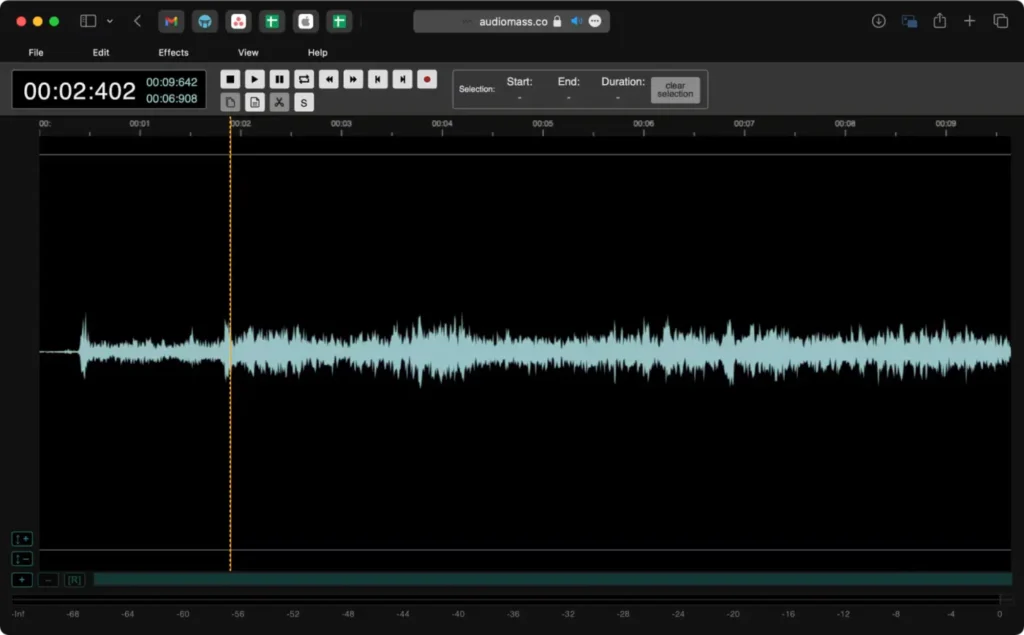
AudioMass pros:
- Free and simple browser-based online editing.
- Record directly in your browser, apply effects, and export your sounds.
Cons of AudioMass:
- Compared to other freeware like Audacity, it has a limited feature set.
- Only truly suitable for short adjustments.
AudioMass is a completely free audio editor that runs entirely within your web browser. It can be used to record audio with your device’s microphone, edit audio files uploaded from your computer, or open files from the internet by pointing it at a URL. This single-track waveform editor offers a simple user interface that will be recognizable to anyone who has previously used programs such as Audacity.
AudioMass not only allows you to trim, edit, move, and duplicate audio, but it also offers a variety of effects such as noise reduction for voice recordings, multiple equalizer effects, a compressor and normalizer, delays, reverbs, and distortion. There are even frequency and spectrum visualizers that appear in a new window.
Aside from the fact that it is absolutely free, one of the best aspects of AudioMass is the lack of access restrictions. When you access the web page, the editor is immediately available for usage. You do not need to register or log in to get started. You can even save an offline version of the editor by selecting Help > Store Offline Version from the menu.
Unfortunately, AudioMass includes very little assistance documentation. However, the toolset is simple and limited enough that it’s difficult to get lost if you’re even remotely experienced with audio editing.
AudioMass price: free
What about apps such as Riverside?
Over the last few years, there has been a boom of apps meant to help podcasters record and produce material. This includes tools like Riverside, Podcastle, and ZenCastr, which mostly provide web-based solutions for podcast recording, editing, and publishing.
Though these apps provide certain editing features—some of which even use AI-powered transcription correction—they are not the audio editors I was searching for. If all you want to do is edit audio, it’s not the way to go, because the tools you need are concealed beneath a layer of functionality geared at content creation.
Having said that, these are effective platforms for producing video or audio interviews, podcasts, and even radio material. They may greatly simplify remote recording, enhance overall production quality, and even improve the editing workflow, so they’re worth considering if you’re looking for an all-in-one solution.
Which is the best audio editor?
Most folks can get started with free editors like Audacity and AudioMass. If you find the free options too restricted, it’s time to look into commercial options like Adobe Audition and Acoustica. Other premium systems provide distinct advantages, such as Hindenburg’s specialization on interviews and podcasts and Audiate’s transcription-based editing.
In truth, the greatest tools for the job are nearly invariably high-end equipment with steep price tags. Audition is an industry standard tool, however the subscription model provides considerable flexibility in terms of usage. If you only need it for a month, this could be a cost-effective option.


